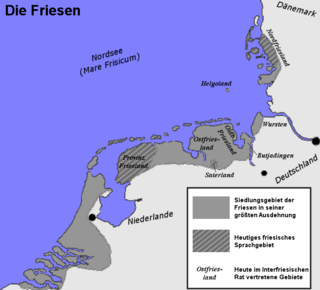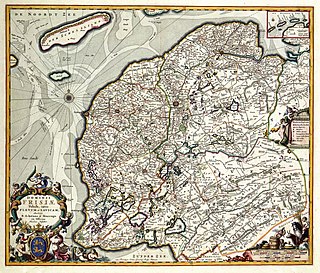Related Research Articles

Friesland, historically known as Frisia, is a province of the Netherlands located in the northern part of the country. It is situated west of Groningen, northwest of Drenthe and Overijssel, north of Flevoland, northeast of North Holland, and south of the Wadden Sea. As of January 2020, the province had a population of 649,944 and a total area of 5,749 km2 (2,220 sq mi).

The Frisians are a Germanic ethnic group indigenous to the coastal parts of the Netherlands and northwestern Germany. They inhabit an area known as Frisia and are concentrated in the Dutch provinces of Friesland and Groningen and, in Germany, East Frisia and North Frisia. The Frisian languages are still spoken by more than 500,000 people; West Frisian is officially recognised in the Netherlands, and North Frisian and Saterland Frisian are recognised as regional languages in Germany.

Year 734 (DCCXXXIV) was a common year starting on Friday of the Julian calendar. The denomination 734 for this year has been used since the early medieval period, when the Anno Domini calendar era became the prevalent method in Europe for naming years.

Frisia is a coastal region along the southeastern corner of the North Sea in what today is mostly a large part of the Netherlands, including modern Friesland and smaller parts of northern Germany. Frisia is the traditional homeland of the Frisians, Germanic people who speak Frisian languages, which together with Anglic languages form the Anglo-Frisian language group.

East Frisia or Eastern Friesland is a coastal region in the northwest of the German federal state of Lower Saxony. It is the section of Frisia in between West Frisia and Middle Frisia in the Netherlands and North Frisia in Schleswig-Holstein.

West Friesland is a contemporary region in the Northwest of the Netherlands, in the province of North Holland.

Redbad was the king of Frisia from c. 680 until his death. He is often considered the last independent ruler of Frisia before Frankish domination. He defeated Charles Martel at Cologne. Eventually, Charles prevailed and compelled the Frisians to submit. Redbad died in 719, but for some years his successors struggled against the Frankish power.

The Frisian Islands, also known as the Wadden Islands or the Wadden Sea Islands, form an archipelago at the eastern edge of the North Sea in northwestern Europe, stretching from the northwest of the Netherlands through Germany to the west of Denmark. The islands shield the mudflat region of the Wadden Sea from the North Sea.

The County of Holland was a State of the Holy Roman Empire and from 1432 part of the Burgundian Netherlands, from 1482 part of the Habsburg Netherlands and from 1581 onward the leading province of the Dutch Republic, of which it remained a part until the Batavian Revolution in 1795. The territory of the County of Holland corresponds roughly with the current provinces of North Holland and South Holland in the Netherlands.

The Middelzee, also called Bordine, was the estuary mouth of the River Boorne now in the Dutch province of Friesland. It ran from as far south as Sneek northward to the Wadden Sea and marked the border between main Frisian regions of Westergoa (Westergo) and Eastergoa (Oostergo). Other historical names for the Middelzee include Bordaa, Borndiep, Boerdiep, and Bordena. The names like Bordine, mean "border".

The Admiralty of Friesland or Frisian Admiralty was one of the five Dutch admiralties of the Dutch Republic. Set up on 6 March 1596, it was dissolved in 1795 during the reforms by the Batavian Republic.
Bubo, also spelled Bobbo, Poppo or Popo, was the pagan duke (dux) of the Frisians in the early eighth century. He is the first ruler whose name is known after Radbod. He did not recognise Frankish supremacy, and his territory probably only encompassed the north of Radbod's Frisia. He was defeated in a short war by the forces of Charles Martel, the duke of the Franks, in the Battle of the Boorne. The Frankish chroniclers, such as the Continuations of Fredegar, Vita Willibroridi of Alcuin and the Annales Mettenses priores, depict Bubo as a rebel and the Frankish invasion as a just war.

Friese Freedom or Freedom of the Frisians was the absence of feudalism and serfdom in Frisia, the area that was originally inhabited by the Frisians. Historical Frisia included the modern provinces of Friesland and Groningen, and the area of West Friesland, in the Netherlands, and East Friesland in Germany. During the period of Frisian freedom the area did not have a sovereign lord who owned and administered the land. The freedom of the Frisians developed in the context of ongoing disputes over the rights of local nobility.

Frisia has changed dramatically over time, both through floods and through a change in identity. It is part of the Nordwestblock which is a hypothetical historic region linked by language and culture.

The Frisian–Frankish wars were a series of conflicts between the Frankish Empire and the Frisian kingdom in the 7th and 8th centuries.

The Frisian Kingdom, also known as Magna Frisia, is a modern name for the Frisian realm in the period when it was at its largest (650-734). This empire was ruled by kings and emerged in the mid-7th century and probably ended with the Battle of the Boarn in 734 when the Frisians were defeated by the Frankish Empire. It lay mainly in what is now the Netherlands and – according to some 19th century authors – extended from the Zwin near Bruges in Belgium to the Weser in Germany. The center of power was the city of Utrecht. In medieval writings, the region is designated by the Latin term Frisia. There is a dispute among historians about the extent of this realm; There is no documentary evidence for the existence of a permanent central authority. Possibly Frisia consisted of multiple petty kingdoms, which transformed in time of war to a unit to resist invading powers, and then headed by an elected leader, the primus inter pares. It is possible that Redbad established an administrative unit. Among the Frisians at that time there was no feudal system.

For around 450 years, from around 55 BC to around 410 AD, the southern part of the Netherlands was integrated into the Roman Empire. During this time the Romans in the Netherlands had an enormous influence on the lives and culture of the people who lived in the Netherlands at the time and (indirectly) on the generations that followed.

The Lordship of Frisia or Lordship of Friesland was a feudal dominion in the Netherlands. It was formed in 1524 when Emperor Charles V finally conquered Frisia.
References
- ↑ "Geschiedenis van het volk der Friezen". Boudicca.de. Archived from the original on 2009-06-08. Retrieved 2009-01-22.
This article needs additional citations for verification .(February 2009) (Learn how and when to remove this template message) |